Travel Notes to Hunan--My son and I had a wonderful trip to Hunan during the summer vacation of 19 years
~~~~~~~~~~~~~~~~~~~~~~~~~~~~~~~~~~~~~~~~~~~~~~~~~~~~~~~~~~~
Preface: Mr. Shen Congwen's "Notes on Traveling to Hunan" uses a natural, simple, flowing writing style to outline a charming "Western Hunan World". In Lao Shen's writing, people are vivid, scenes are vivid, and objects are also spiritual, with a lively flavor of folk.
Many years ago, I had an appointment with a friend in Xiangxi. However, the plan could not keep up with the changes, and the trip to Xiangxi was stranded time and time again. This summer, I approached Xiangjiang River with my son and headed west, fulfilling my dream of Xiangxi for many years.
In recent years, I have also visited some historical monuments and cultural cities with my family and friends, and enjoyed many natural scenery and beautiful scenery. Everywhere I went, there were scenery and stories that I wanted to keep in my memory forever. But every time I came back, I was tired and never left a word on the paper. This trip to Hunan was also the first trip for my son and I. We wanted to record every detail of the trip, so we had the following detailed to trivial travel notes to remember a middle-aged mother and a young man's beautiful trip to western Hunan.
~~~~~~~~~~~~~~~~~~~~~~~~~~~~~~~~~~~~~~~~~~~~~~~~~~~~~~~~~~~~~~
[August 11, the first day of the itinerary: Jinan-Changsha]
Today's main itinerary: May Day Square--Hunan Normal University--Hunan University--Yuelu Mountain:(Yuelu Academy--Aiwan Pavilion--Yuelu Ancient Temple--Juzizhou)
~~~~~~~~~~~~~~~~~~~~~~~~~~~~~~~~~~~~~~~~~~~~~~~~~~~~~~~~~~~~~~
Take flight sc2193 from Jinan at 7:25 a.m. and arrive at Changsha Huanghua Airport at 9:35.
When we left home at around 5 o'clock, it was still not dawn. Affected by Typhoon Licima, Jinan was feeling cool in the pouring rain. Arriving in Changsha at 9:30, and the moment I walked out of the airport, I was surrounded by Changsha's heat wave. My son joked: Everyone else is on a summer vacation, but we are on a daily journey.

Jinan at the time of departure was raining heavily


When we arrived in Changsha, the sun was shining brightly!
~~~~~~~~~~~~~~~~~~~~~~~~~~~~~~~~~~~~~~~~~~~~~~~~~~~~~~~~~~~~~~
The master in charge of picking up the plane took us to Changsha Mini Hotel located on Torch Middle Street. On the way, the master responsibly introduced us to the traffic conditions around the hotel where we stayed. Unfortunately, there was no subway station near the Minyou Hotel where we stayed.
Let me mention here that although our trip is a group tour, since it is a group tour, tourists like us who arrive early on the first day can have a day of free travel time. The pick-up master suggested that we give up the time-wasting way of taking the bus and then taking the subway, and take a taxi directly to the place we want to go, and listen to people's advice to eat enough. After the hotel put down our luggage, we took a Didi Express to Changsha's most prosperous Wuyi Square. The reason why I chose to come to Wuyi Square first was that we had made a guide before coming and made it clear that the attractions we wanted to visit were all around Wuyi Square. When we were tired, we could have lunch in Wuyi Square and make some adjustments before going to Yuelu Mountain.

As you can see from the map, our itinerary today is all in these red circles next to each other.
~~~~~~~~~~~~~~~~~~~~~~~~~~~~~~~~~~~~~~~~~~~~~~~~~~~~~~~~~~~~~~
Today's first stop: Wuyi Square
~~~~~~~~~~~~~~~~~~~~~~~~~~~~~~~~~~~~~~~~~~~~~~~~~~~~~~~~~~~~~~


At about 10:30, we arrived at Wuyi Square on the Didi Express. Wuyi Square is full of high-rise buildings and shopping malls, which is not much different from the downtown pedestrian streets in various places. We strolled a few streets, found the KFC house closest to the subway entrance and had a simple lunch. At 11:30, we took Metro Line 2 and took two stops to Rongwan Town to get off the subway.
~~~~~~~~~~~~~~~~~~~~~~~~~~~~~~~~~~~~~~~~~~~~~~~~~~~~~~~~~~~~~~~~
Today's second stop: Hunan Normal University
~~~~~~~~~~~~~~~~~~~~~~~~~~~~~~~~~~~~~~~~~~~~~~~~~~~~~~~~~~~~~~~~
At around 11:40, after getting off the subway from Rongwan Town, my son and I rode a motorcycle and walked south. The first thing we passed was Hunan Normal University. This country's first batch of 211 universities was established in 1938. The campus road is shaded by trees and beautiful environment. Because of our limited time, we only stopped briefly at Hunan Normal University and focused our visit on Hunan University, the next stop.


~~~~~~~~~~~~~~~~~~~~~~~~~~~~~~~~~~~~~~~~~~~~~~~~~~~~~~~~~~~~~
Today's third stop: Hunan University
~~~~~~~~~~~~~~~~~~~~~~~~~~~~~~~~~~~~~~~~~~~~~~~~~~~~~~~~~~~~~
Further south from Hunan Normal University is Hunan University. Hunan University originated from the Yuelu Academy founded in 976 AD. After changes in the Song, Yuan, Ming, and Qing dynasties, it has always maintained the continuity of cultural education and teaching. In 1903, it was transformed into Hunan University, and in 1926 it was named Hunan University. After the founding of the People's Republic of China, Li Da, representative of the First National Congress of the Communist Party of China and educator, was appointed as the first president of Hunan University in New China. Comrade Mao Zedong personally inscribed the name of the school. Thanks to Du Niang for providing the above information.
Braving the sun at 12 o'clock noon, we began to ride a bicycle to visit Hunan University. The architectural style of each college of Hunan University is different. Some colleges are located in old buildings with a long history, while some emerging colleges have a modern and fashionable architectural style. Huda, which is suitable for ancient times and modern times, reflects ancient times and modern times, and blends history and future.









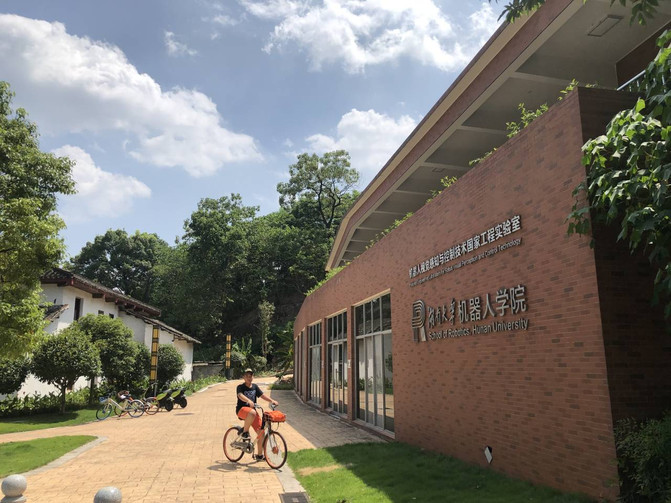
Because it was a holiday, there were not many students in each college. My son and I leisurely shuttled through each college, feeling the different heritage of the quiet lake.
~~~~~~~~~~~~~~~~~~~~~~~~~~~~~~~~~~~~~~~~~~~~~~~~~~~~~~~~~~~~~~~~~
Today's fourth stop: Yuelu Mountain
Yuelu Mountain Tour Route: Yuelu Academy--Aiwan Pavilion--Qingfeng Spring, Yangyun Pavilion--Gulu Mountain Temple--South Gate
~~~~~~~~~~~~~~~~~~~~~~~~~~~~~~~~~~~~~~~~~~~~~~~~~~~~~~~~~~~~~~~~~
1. Yuelu Academy
My son and I walked and stopped around Huda Li for almost two hours, and arrived at Yuelu Academy at around 2:30 p.m., which is located at the foot of the mountain near the south gate of Yuelu Mountain. In fact, after getting off the subway from Rongwan Town, it takes less than 5 minutes to ride to the east gate of Yuelu Mountain. If you enter the east gate, you can come out from the south gate and visit the university. My son and I both wanted to visit two universities first and then climb the mountain, so we decided to ride an extra 20 minutes, entering Yuelu Mountain from Nandaemun and exiting from Dongdaemun.

Follow the chronological signs and enter Yuelu Academy, one of the four major academies. In the ninth year of Kaibao of the Northern Song Dynasty (976 AD), Zhu Dong, the prefect of Tanzhou, officially established Yuelu Academy based on the establishment of schools by monks and donated funds from the government.
As one of the oldest universities in the world, its ancient traditional academy buildings have been completely preserved today. Every courtyard, every stone tablet, every brick, and every wind lotus shine with the humanistic spirit tempered by time.





There are two plaques above the pulpit. The one in front was written by Kangxi, and the one behind is a royal pen by Qianlong.

In the third year of Qiandao (1167 AD), Zhu Xi visited and discussed studies with Zhang Wei, holding the famous "Zhu Zhang Lecture" in history. There was an endless stream of people who came to listen. People at the time described "for a while, there were many horses, and the water was dry up after drinking." This conference also promoted the development of Neo-Confucianism in the Song Dynasty and ancient Chinese philosophy, so it was not only Changsha, but also a grand event in the history of ancient Chinese culture. It is said that the two chairs placed on the podium were the seats where Zhu Zhang spoke.
Behind the pulpit are the Imperial Book Pavilion and the back garden








~~~~~~~~~~~~~~~~~
2. Aiwanting
Coming out from the back door of the academy and walking along the winding mountain path, you will find Aiwan Pavilion. On the mountain road, ancient trees and green bamboos complement each other, and Aiwan Pavilion gradually reveals her face in the green.
Aiwan Pavilion was originally named Hongye Pavilion, also known as Aifeng Pavilion. It was founded in 1792 in the 57th year of Qianlong of the Qing Dynasty and was founded by Luo Dian, president of Yuelu Academy. Together with the Zuiweng Pavilion in Chuxian County, Anhui Province (1046), the Lake Center Pavilion in West Lake in Hangzhou (1552), and the Taoran Pavilion in Beijing (1695), they are called the four famous pavilions in China. Later, Bi Yuan, the governor of Huguang, according to Du Mu,"The stone paths are sloping from the distance, and there are families deep in the white clouds." The poem "Parking and sitting in Love Maple Forest at night, Frost leaves are redder than February flowers" was renamed Aiwan Pavilion. Aiwan Pavilion has gone through many vicissitudes, and has been restored one after another during the Tongzhi, Guangxu and Xuantong periods of the Qing Dynasty. Among them, in the autumn of the third year of Xuantong, when Mr. Cheng Songwan, the supervisor of Hunan School, presided over the restoration, he engraved the couplet written by Luo Dian,"The mountain path is red at night, and the peach trees are newly planted 500 years old; the clouds are deep and green, and a pair of tame cranes are waiting to be caged". On the pillar of the pavilion.
When Hunan University was renovated again in 1952, President Li Da sent a special letter asking Mao Zedong to inscription the number of the "Love Evening Pavilion" pavilion. In his youth, Mao Zedong studied at Changsha No. 1 Normal School. He often went to Yuelu Academy with Luo Xuezan, Zhang Kundi and others, and met with Cai Hesen at Aiwan Pavilion to talk about the current situation and explore the truth. For this reason, Li Da wrote to Mao Zedong requesting the name of the bookstand, and Mao Zedong happily accepted the request. Continue with the above picture.









~~~~~~~~~~~~~~~~~~~~~
3. Qingfeng Spring, Yangyun Pavilion
Continue up the mountain road and after climbing a relatively steep mountain road, you can see a spring hole called "Qingfeng Spring". This spring is not the main attraction of Yuelu Mountain, but since you have passed by, stop and rest. Take a look. There is a pavilion next to "Qingfeng Spring" called "Yangyun Pavilion". This pavilion is also called the Northern Expedition Martyrs Pavilion. It can be seen from the name that this pavilion was built to commemorate the martyrs of the Northern Expedition. Therefore, the age of this pavilion is not very long ago.








~~~~~~~~~~~~~~~~~
4. Gulushan Temple
Not far from Yangyun Pavilion is a temple-Gulushan Temple. Lushan Temple is an ancient temple in the early Jin Dynasty. It was the earliest large temple where Buddhism entered Hunan. During the Shenzong Dynasty of the Ming Dynasty, it was renamed Wanshou Temple, and in the early years of the Republic of China, it was renamed Gulushan Temple. Du Fu, the great poet of the Tang Dynasty, once praised the grandeur of the temple with the poem "The temple gate opens high into the Dongting Field, and the temple feet are inserted into the Chisha Lake." Major buildings such as the Daxiong Hall were bombed in 1944, leaving only the gate and Guanyin Pavilion, which have now been renovated. There is a banner of "Ancient Lushan Temple" on the gate, and on both sides are "The First Scenic Spot of the Han and Wei Dynasties, the First Taoist Hall in Hunan". Ancient maples outside the door stand tall and covered in thick shade. The garden inside the door sway with bamboo groves and hundreds of flowers competing for beauty. Guanyin Pavilion is a brick-and-wood structure. It was renovated in 1955 and restored to its original appearance in 1980. A thousand-handed Guanyin statue was placed in the shrine in the hall.






~~~~~~~~~~~~~~~~
Out of Lushan Temple, along the mountain road to the east, there are also scenic spots such as Yunlu Palace, the former site of the Xinmin Society, the Changsha Battle Monument, Huangxing Tomb, Cai E Tomb, Wanjing Garden, and Bird Language Forest. It was already past 5 o'clock when we came out of Lushan Temple. Considering that we still had to go to Juzizhou and didn't have time to visit the various attractions in Yuelu Mountain one by one, we gave up with some regret continuing up the mountain and then going to Dongdaemun. plan. We chose to go down the mountain road to the south gate of Yuelu Mountain.
I told my son: Regrets during the journey are inevitable. Today's regrets and misses may exist to give you the opportunity to visit Yuelu Mountain again in the future.
At Nandaemun, we met a volunteer from Hunan University. The little girl enthusiastically took photos of tourists and gave us a brief introduction to the origin of Yuelu Mountain. At that time, my son and I didn't completely write down her introduction. The following text was posted on Baidu after I came back. Continue to thank Du Niang, which is roughly the introduction of the little girl at that time.
Yuelu Mountain Scenic Area is located in Yuelu District, Changsha City, Hunan Province, with an altitude of 300.8 meters and an area of 35.2 square kilometers. It is the last peak of the 72 peaks of Hengshan Mountain in Nanyue. It is located in the Juzizhou Tourist Scenic Area. It is an urban mountainous scenic spot and one of the four major maple attractions in China. If autumn comes, you can appreciate the maple leaves all over the mountains and fields, as magnificent as burning clouds. Yuelu Mountain is named after the "Nanyue Ji" in the Southern Song Dynasty,"Eight hundred miles around the Nanyue Mountains are headed by Hui Yan, and Yuelu is the foot". It integrates Confucianism, Buddhism and Taoism, which integrate the essence of Chinese ancient culture, and incorporates historical thoughts. The cultural connotation of Yuelu Mountain jointly developed by giants, eminent monks and famous Tao, and literati. The scenic area includes Yuelu Academy, Aiwan Pavilion, Lushan Temple, Yunlu Palace, the former site of the Xinmin Society, Huangxing Tomb, Cai E Tomb, and the former site of the wartime headquarters of the 9th Theater Command. In January 2012, Yuelu Mountain Scenic Area was announced by the National Tourism Administration as a national 5A-level tourist attraction.
After listening to the volunteers 'explanation of Yuelu Mountain, my son and I ended today's trip to Yuelu Mountain.




~~~~~~~~~~~~~~~~~~~~~~~~~~~~~~~~~~~~~~~~~~~~~~~~~~~~~~~~~~~~~~~~~
Today's fifth stop: Juzizhou
~~~~~~~~~~~~~~~~~~~~~~~~~~~~~~~~~~~~~~~~~~~~~~~~~~~~~~~~~~~~~~~~~
Coming out from the south gate of Yuelu Mountain, at about 5:30, we will head to the last attraction on our itinerary for today-Juzizhou. After passing through a snack street, take Metro Line 4 at Hunan University Subway Station and take two stops to Rongwan Town. In Rongwan Town, transfer to Metro Line 2 and take one stop to Juzizhou Station.

Juzizhou Scenic Area is located in the center of the Xiangjiang River opposite the urban area of Changsha City, Hunan Province. It is the largest famous island in the Xiangjiang River, with an area of 91.4 hectares. From south to north, it traverses the center of the river, west to Yuelu Mountain, and east to Changsha City. It is surrounded by water on all sides and stretches for more than ten miles. The narrow part is about 40 meters across and the wide part is about 140 meters across. The shape is a long island and is a national key scenic spot. We didn't have an aerial camera and couldn't take a panoramic view of Juzizhou, so we found a photo online and posted it.

Coming out of the subway entrance is the ticket counter for scenic tour buses and cruise ships to tour Xiangjiang River at night. My son and I bought tickets for the tour bus and planned to take a ride along the continent to watch.
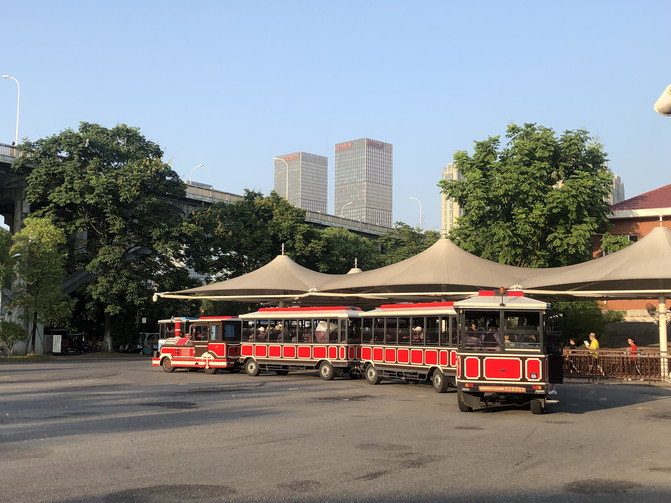

We took a tour bus all the way to the head of Orange Island, planning to visit the art sculptures of young Mao Zedong before the sun set, and then go back to view other attractions. When I arrived at the head of Orange Island, I saw a sea of people. I finally found a perfect location, so I quickly took out my mobile phone and took a few photos. The timing of these photos was just right. I actually took the feeling of my son visiting alone. I was in a beautiful mood. However, since it was afternoon, the sun was just west of the statue of the Chairman, and the statue of the Chairman was facing east, so no matter how it shone, it would be backlit. If it came in the morning, the results would be better. Here, I would also like to remind everyone that if you want to visit Orange Island, it is best to come in the morning, because taking photos will never be backlit. Continue with the above picture.




Behind the statue of Chairman Juzizhou Head stands a huge white marble monument, which is particularly eye-catching. The front is engraved with Mao Zedong's handwritten calligraphy "Juzizhou Head", and the back is the full text of "Qinyuanchun·Changsha". "Qinyuanchun·Changsha":"In the cold autumn of independence, the Xiangjiang River goes north and at the head of Juzi Island. See the mountains are red and the forests are dyed."

After visiting Juzizhou Head, we stopped and stopped along the bank of the sandbar and enjoyed the scenery along the Xiangjiang River.





At around 7 o'clock, the sun was setting, the sky was gradually getting dark, and the lights on both sides of the Xiangjiang River were brightly lit. However, my son and I were already hungry and exhausted by this time, and we no longer had the interest in appreciating any scenery.
I checked today's exercise record-21550 steps. The number of steps for the first time exceeded 20,000. No wonder I felt tired. I quickly walked to the boarding point of a tour bus, got on the tour bus, and returned to the entrance of the scenic spot. We planned to find a restaurant to have a big meal, but the delicious food no longer had any temptation for us. We quickly caught a Didi Express and returned to the hotel. We bought instant noodles and a bunch of snacks from the supermarket next to the hotel. It was already 8 p.m. when we returned to the hotel.
After eating and washing, at around 9 o'clock, we finally lay in the bed of the hotel. While watching Hunan Entertainment, we recalled that during this day's free travel, my son and I used our mobile phones, Baidu maps and Gaode maps., both the subway and the bicycle, we successfully checked in all the attractions we did when we came to visit. We all felt a little proud. Before going to bed, we couldn't help but sigh. It was such a fulfilling and wonderful day. I look forward to visiting Shaoshan with the group tomorrow!
~~~~~~~~~~~~~~~~~~~~~~~~~~~~~~~~~~~~~~~~~~~~~~~~~~~~~~~~~~~~~~~~~~~~
~~~~~~~~~~~~~~~~~~~~~~~~~~~~~~~~~~~~~~~~~~~~~~~~~~~~~~~~~~~~~~~~~~~~
[The second day of the itinerary on August 12: Changsha-Shaoshan, Xiangtan-Zhangjiajie]
Today's main itinerary: Zhangjiajie, the former residence of Chairman Mao in Shaoshan (charming Xiangxi large-scale performance)
~~~~~~~~~~~~~~~~~~~~~~~~~~~~~~~~~~~~~~~~~~~~~~~~~~~~~~~~~~~~~
Today's first stop: Chairman Mao's Former Residence in Shaoshanchong
~~~~~~~~~~~~~~~~~~~~~~~~~~~~~~~~~~~~~~~~~~~~~~~~~~~~~~~~~~~~~
Early this morning, a middle-aged tour guide named A Yong picked us up at the hotel. At this time, there were already three or four tourists on the bus, but my son and I found that the front seats were empty. The tourists who came up first all unanimously chose to sit behind the bus. People who often ride buses know that it is more comfortable to sit in the front, but it will be bumpy at the back. As for the group members of our group, those who came first took the initiative to sit back, leaving the more comfortable seats in the front row for friends who got on the bus later. You must know that we are all strangers from all over the motherland! The actions of these more than a dozen group members immediately won a great impression on my son and I. This shows that our trip will not only not be a rush for seats, but will also be an extremely harmonious and exciting group tour! This also shows that the quality of our Chinese people has been quietly undergoing good changes. This is really so happy! My son and I also hurried to the back of the car. After sitting down, I turned around and said hello to everyone with a smile. I felt that the group members were very beautiful this time!

Tour guide A Yong said that there were a total of 9 groups of families on our trip. Next, the bus would have to go to different hotels to pick up several other group members. I think it would be good to follow the bus to tour downtown Changsha. At about 8:30, all the guests had gathered. At this time, Ah Yong asked, all of my friends arrived in Changsha yesterday. I believe everyone has also taken a little tour of Changsha. Did everyone find anything? The tour guide's question also aroused my thinking. It seemed that something was wrong, but I couldn't tell what was wrong. At this time, A Yong said, let's recall that in our urban area of Changsha, have you seen any buildings of a period? With the tour guide's questions, I recalled that I had never seen them before. Everything you can see in the city of Changsha are buildings. This is what's wrong. Logically speaking, how could a city where the ancient tomb of Mawangdui in the Han Dynasty be excavated not even see a house with a sense of time? A Yong saw everyone's confused expressions and was very satisfied with the foreshadowing he had laid. Then, he introduced us historical novices to a very tragic fire in modern history-the Kuomintang burned down Changsha. Regarding this period of history, Baidu has introduced it in detail and will not go into detail one by one. However, after listening to Ah Yong's introduction, I only have one feeling: war is too cruel and terrible, and it is really happy to live in a peaceful era!
~~~~~~~~~~~~~~~~~~~~~~~~~~~~~~~~~~~~~~~~~~~~~~~~~~~~~~~~~~~~~~
Shaoshan: Former Residence of Chairman Mao
~~~~~~~~~~~~~~~~~~~~~~~~~~~~~~~~~~~~~~~~~~~~~~~~~~~~~~~~~~~~~~
The bus travels all the way to Xiangtan City in the southwest. We are about to leave Changsha and go to today's first and only attraction-Chairman Mao's former residence. About an hour and a half later, we arrived at Chairman Mao's former residence. When we entered the high-speed toll station in Shaoshan, a local girl from Shaoshan got up on our bus. She was a local full-time tour guide at Chairman Mao's former residence. On the bus, she repeatedly emphasized many matters to pay attention to during the visit, and everyone listened very carefully. This is Chairman Mao's former residence. It can be said that everyone was listening to the tour guide's explanation piously. His son, who had been sleeping soundly all the way, was now sitting upright and extremely serious.
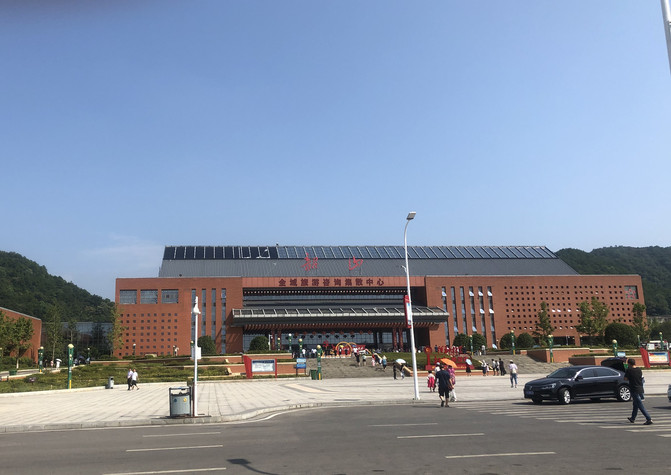
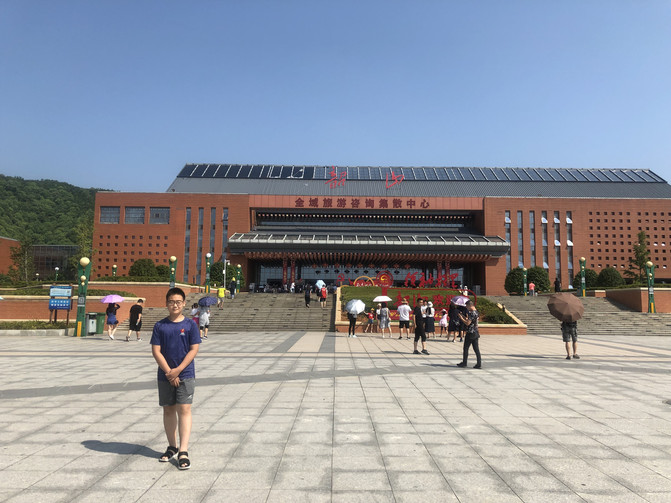
This is a tourist distribution center. From here, you will find the place where Chairman Mao once lived.
Our regiment first went to the bronze statue of Chairman Mao and laid a wreath, which stood in Shaoshanchong Square. It is backed by Shaofeng and is the center of Shaoshanchong. It is very close to the Chairman's former residence, Mao's Ancestral Hall, and Comrade Mao Zedong Memorial Hall in Shaoshan. Here, everyone visited freely for about half an hour.







After visiting the attractions around the chairman's bronze statue, the tour guide gathered everyone to Chairman Mao's former residence. It was about 5 minutes 'walk. The first thing that came into view was a large lotus pond.

As soon as I took a photo, the tour guide said that after turning a corner, there was also a large lotus pond in front of the chairman's house, and it would be more beautiful to take pictures there. What the tour guide said was absolutely right. After a small turn, there are several thatched houses hidden among the green mountains and clear waters. It is indeed a treasure land of outstanding people.




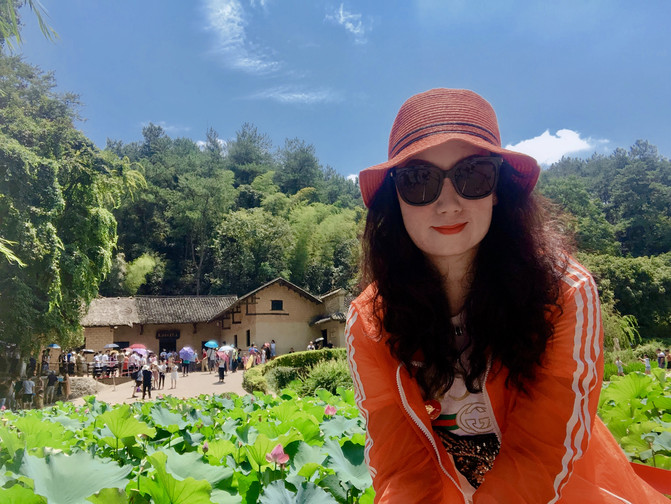





This renovated Huizi-style tile-roofed house called "Nan 'an" was the place where Chairman Mao went to private schools when he was a child. The so-called "South Bank" refers to the south bank of the pond in front of the former residence. This private school is randomly named, which is quite petty.
Coming out of the Chairman's former residence, at about 12 o'clock, we had a group meal in the local area. One of them was Mao's braised pork, a dish that Chairman Mao liked very much. At around 1 o'clock, we took a bus to Xiangxi to Zhangjiajie, which we had long longed for.
~~~~~~~~~~~~~~~~~~~~~~~~~~~~~~~~~~~~~~~~~~~~~~~~~~~~~~~~~~~~~
Today's second stop: Arrive in Zhangjiajie
~~~~~~~~~~~~~~~~~~~~~~~~~~~~~~~~~~~~~~~~~~~~~~~~~~~~~~~~~~~~~
It is more than 400 kilometers from Shaoshan to Zhangjiajie. A Yong said that the bus will take more than 5 hours. I calculated that 400 kilometers and 4 hours are almost enough. Why does it take more than 5 hours? A Yong said that Hunan's highways have a speed limit of 120 unlike other places, and Hunan's highway has a speed limit of 80, so the driving time is longer. Well, then consider it to recuperate.
About four hours after the car ride, at 5 p.m., I woke up from a sleepy stare. I found that without realizing it, we had entered the mysterious mountainous area of western Hunan! Moreover, I finally say goodbye to our passionate Sun father-in-law. The clouds in the mountains have their own attitude, and I like it no matter what kind!






At 6:20 p.m., we finally arrived in Zhangjiajie and checked into Jianghan Villa Hotel. After dinner, everyone gathered at 7 o'clock and went to Zhangjiajie Charming Xiangxi International Cultural Square to watch the large-scale national song and dance evening of "Zhangjiajie Charming Xiangxi".


The charm of Xiangxi on the plaque was written by Huang Yongyu, and the theme song at the party was sung by three Hunan singers, Song Zuying, Zhang Ye and Chen Sisi.




The entire performance includes:
1. Miao inspiration: Miao inspiration in Xiangxi is the most unique dance art in the Miao area of my country.
2. Border Town: According to Mr. Shen Congwen's story of Cuicui in the border town, it depicts the love affair between Cuicui, Tianbao and Nuosang. The beautiful scene reflects the feelings of the children of Xiangxi.
3. Climbing stairs: It is a unique marriage and love custom of the Yao people in Chashan, Jinxiu, Guangxi. The Yao people have always had a tradition of marrying women to men and having freedom in love. The houses he lives in are all wooden structures and dry fences. When the girl in charge was old enough to fall in love, her parents arranged for her to live in a penthouse so that she could have a door-to-door meeting with young men. Whenever night falls, his girl waits for her lover in the penthouse. Show the enthusiasm of the Yao young man in the form of song and dance. In 2012, this program appeared on CCTV's Spring Festival Gala under the name of "Chasing Love".
4. Maogus Dance: Maogus Dance originated in the Tujia sacrificial ceremony and is an ancient dance.
5. Masang Shuer builds a lantern stand: "Masang Shuer builds a lantern stand" is a revolutionary folk song popular in western Hunan that is sung by a man and a woman. It is a folk song in Sangzhi County, Zhangjiajie. Song Zuying also sang it in the Golden Hall of Vienna.
6. Daughters 'Club: Generally speaking, the days from July 7th to 12th of the lunar calendar are traditional auspicious days for "Daughters' Club" and have now developed into a national festival in areas where Tujia people are concentrated.
7. Crying to marry: Crying to marry is a unique custom of the Tujia people. It has been inherited from ancient times to the present. Through crying and singing, it vividly expresses the complex psychology and delicate feelings hidden in the bottom of the girl's heart. Half a month to one month before marriage, the bride begins to cry and sing. The forms include one person crying, two people crying together, and many people crying together. The content of crying and singing includes criticism of the old system, ridicule of matchmakers, expression of old feelings, nostalgia for relatives, praise of women, and longing for the future. With the progress of society and the improvement of civilization, the content of crying and marrying has also been constantly renovated.
8. Xiangxi's corpse chase: I was surprised that "Charming Xiangxi" put it on the stage. The fundamental purpose is to satisfy the audience's curiosity and explore, and let everyone experience the unique and mysterious geography and humanities of Xiangxi. The live music was horrific and the scene was eerie. My son and I watched it with creeps.
9. Flying Knife Performance: A program that interacts with the audience. Flying Knife artists are highly skilled and brave, but the audience is unscathed and very exciting.
The above nine programs are indoor programs, as well as off-site campfire performances. They are mainly Tujia hard Qigong performances, witchcraft performances by the three major Gu fans in western Hunan (including going to the Dao Mountain, walking on the Iron Plough, and going down the Sea of Fire), and large-scale Tujia waving dance performances.
After 9 o'clock, we returned to the hotel to rest. Looking forward to tomorrow's trip to Zhangjiajie.
~~~~~~~~~~~~~~~~~~~~~~~~~~~~~~~~~~~~~~~~~~~~~~~~~~~~~~~~~~~~~~
~~~~~~~~~~~~~~~~~~~~~~~~~~~~~~~~~~~~~~~~~~~~~~~~~~~~~~~~~~~~~~
[August 13, the third day of the itinerary: Zhangjiajie]
Today's main itinerary:
Morning: Wulingyuan, Zhangjiajie-Yuanjiajie (Avatar, World's No. 1 Bridge, Hundred Dragons Ladder)-Jinbianxi Grand Canyon Scenic Area
Afternoon: Zhangjiajie Tianmen Mountain Scenic Area-Tianmen Cave-Ghost Valley Plank Road-Glass Plank Road-Tianmen Mountain Cableway Road
~~~~~~~~~~~~~~~~~~~~~~~~~~~~~~~~~~~~~~~~~~~~~~~~~~~~~~~~~~~~~~~
Popular science Zhangjiajie:
Zhangjiajie is a prefecture-level city under the jurisdiction of Hunan Province, formerly known as Dayong City, and governs 2 municipal districts (Yongding District, Wulingyuan District) and 2 counties (Cili County and Sangzhi County). It is located in the northwest of Hunan, in the middle and upper reaches of the Lishui River, and belongs to the hinterland of the Wuling Mountains.
The name of Zhangjiajie was first found in the preface to Zhang's Genealogy in the fourth year of Chongzhen in the Ming Dynasty (1631). The author of the preface is Zhang Zaichang, the sixth grandson of Zhang Wancong, the commander of Dayong Office of Yongding Wei. During the Hongzhi period of the Ming Dynasty (1488-1506), the court saw Zhang Wancong's meritorious guard and awarded him the "mountain forest land" in the area of what is now Zhangjiajie National Forest Park as a fief. So he raised his family up the mountain to maintain business. In the third year of Chongzhen of the Ming Dynasty (1630), Zhang Zaihong, the sixth grandson of Zhang Wancong, was awarded a regiment official and a government office was set up here. This area became the hereditary territory of the Zhang family and was called "Zhangjiajie".
~~~~~~~~~~~~~~~~~~~~~~~
Today's first stop: Wulingyuan Core Scenic Area
~~~~~~~~~~~~~~~~~~~~~~~~
We entered Zhangjiajie early in the morning at the gate of Wulingyuan Scenic Area. Tickets for Zhangjiajie Scenic Area can be used for 4 days, which means that tourists can enter and exit the scenic area with this ticket during these 4 days. We can see how big the Zhangjiajie Scenic Area is from the time of using the ticket.









~~~~~~~~~~
1. Hundred Dragons Ladder
~~~~~~~~~~
Entering the park, we took a scenic tour bus to the foot of the Hundred Dragons Ladder. Go straight to the core scenic area of Yuanjiajie.


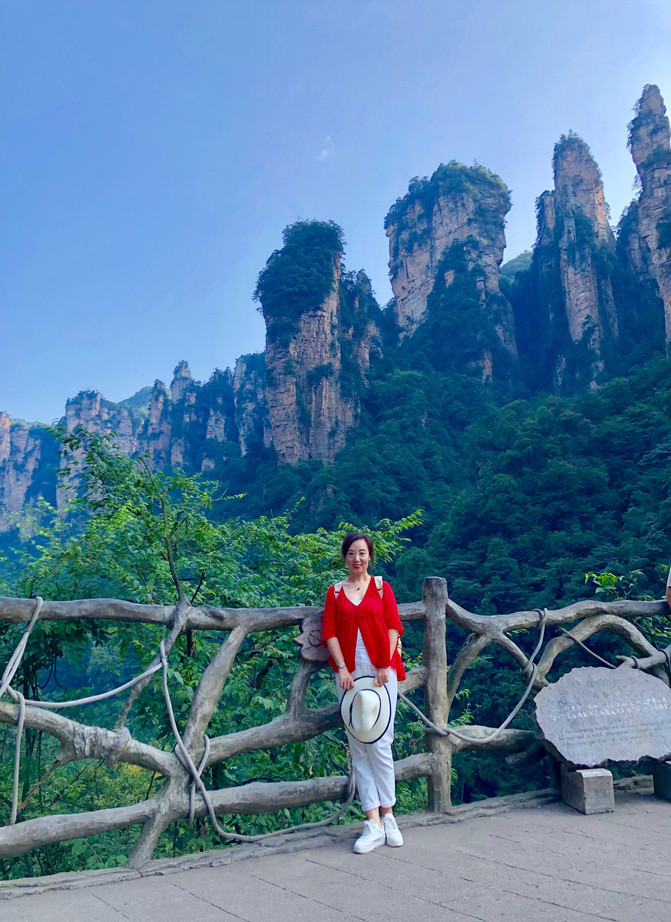

Coming down from the Hundred Dragons Ladder, you will reach the core scenic spot of Yuanjiajie. The tour guide said that you should watch the scenery with your left hand and move forward with your right hand. That is to say, all the observation platforms are on the left hand. After enjoying the beautiful scenery, you will return to the main road on the right hand and continue moving forward.



The main attractions in this section include: Ecstasy Terrace, Hallelujah Mountain, the First Bridge in the World, etc. Let's first see how the Charming Platform is a kind of beauty that seizes people's souls.
~~~~~~~~~~
2. Ecstasy Platform
~~~~~~~~~~





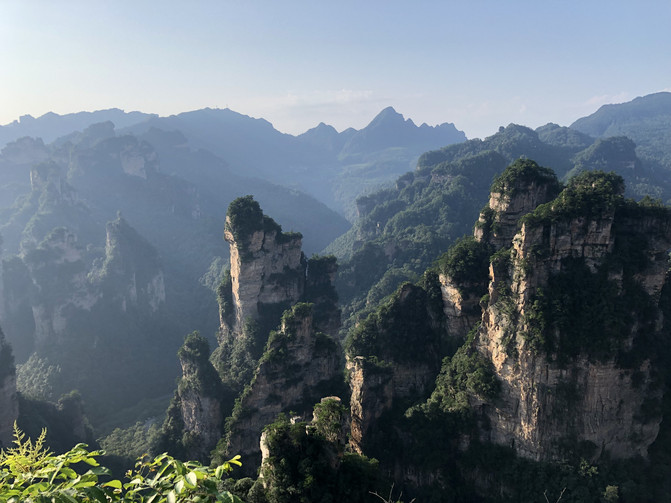
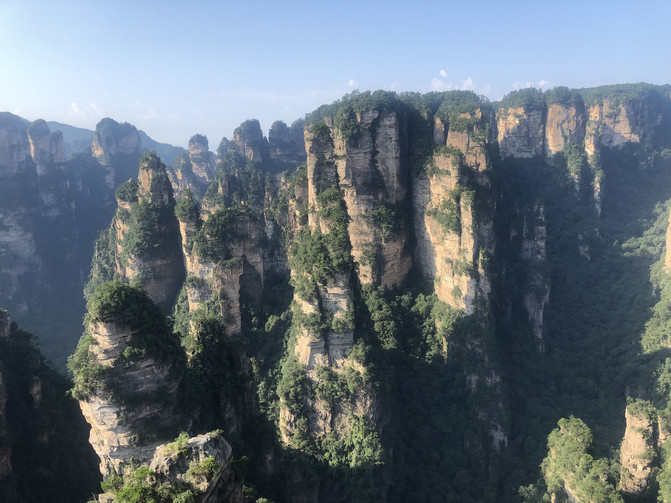






~~~~~~~~~~~~~~~~~~~~~~~~~~~~
3. Hallelujah Mountain (Nantian Pillar-Qiankun Pillar)
~~~~~~~~~~~~~~~~~~~~~~~~~~~~
Along the boardwalk, not far away, you will find the Hallelujah Mountains. On January 25, 2010, the Qiankun Pillar of Nantian in Zhangjiajie was renamed Hallelujah Mountain in "Avatar". It is understood that a large number of prototypes in "Planet Pandora" in the movie "Avatar" come from the mountains of Zhangjiajie, among which the picture of "Nantian Pillar" has become the prototype of "Hallelujah Mountain", or suspended mountains.







~~~~~~~~~~~~
4. The first bridge in the world
~~~~~~~~~~~~
The first bridge in the world is the "first bridge in the world." You see, the two peaks are connected by a corridor to form a natural bridge hole. They usually puff clouds and puff out mist, and their momentum is spectacular. The bridge deck is about two meters wide, more than 20 meters long, and an absolute height of 350 meters. The pine trees are tall and straight on the bridge, and ancient vines hang from the bridge, making it unfathomable under the bridge. Walking on the bridge, I saw the mist rising, the pine waves roaring, and the stone bridge seemed to tremble, shaking and shaking, which was shocking. This is a unique scenery in Zhangjiajie and a miracle of nature.



Compared with other scenic spots in Zhangjiajie, the quartz sandstone peak forest in Yuanjiajie Scenic Area is in the development stage of young and middle-aged people. It includes almost all the characteristics of Wulingyuan peak forest. It has beautiful stone peaks, high mountains, dangerous gorges, and clear waters. The characteristics of green mountains. Being there is really a shocking beauty, and it makes people linger and can't bear to leave for a long time.
~~~~~~~~~
5. Jinbianxi
~~~~~~~~~
Get off from the No. 1 Bridge in the world, go to the scenic spot tour bus point, take the bus back to the Hundred Dragons Ladder, take the ladder down, and continue to take the scenic spot tour bus to Jinbian River. Jinbian River is named after it flows through Jinbian Rock. It has a total length of 5700 meters and runs between the cliffs and peaks. The valley has lush vegetation and the stream is clear all year round. It is called the "Landscape Gallery" and the "Wonderland on Earth." There is a poem praising:"Clear flowing water and green mountains. The mountains are like painting screens and people are like immortals. If immortals walk in the painting, they look at the sky step by step."





In the Jinbianxi Scenic Area, wild monkeys can be seen playing everywhere.



~~~~~~~~~~~~~~~~~~~
Today's second stop: Tianmen Mountain Scenic Area
~~~~~~~~~~~~~~~~~~~
Keppe Tianmen Mountain:
Tianmen Mountain Scenic Area is located 8 kilometers south of the Urban area of Zhangjiajie City. It is a national 5A-level tourist area and a mountainous natural scenic spot. The total area is 96 square kilometers, and the mountain top area reaches 2 square kilometers. The main peak of Tianmen Mountain Scenic Area is 1,518.6 meters above sea level. It is the highest mountain in Zhangjiajie. It was called Songliang Mountain in ancient times, also known as Mengshan and Fanghu Mountain. The scenic area has steep mountains and beautiful rocks and valleys, which originate from the typical Danxia landform.
In order to explore the mystery of the top of the mountain, a 1098-level stone ladder road with eaves hanging straight up has been dug on the cliffs. People climbing high and trying to escape danger are called the "climbing ladder" to find victory and explore the secluded path.
~~~~~~~~~~~~~~~~~~~~~
We booked a B package at the foot of the mountain. The tour route for the B package is to take a scenic tour bus first, go up the mountain along the Zhuanshan Highway, and take the cableway directly to the urban area of Zhangjiajie when going down the mountain. When you arrive at the entrance of the scenic area, you can look up and see Tianmen Cave on the distant mountains.

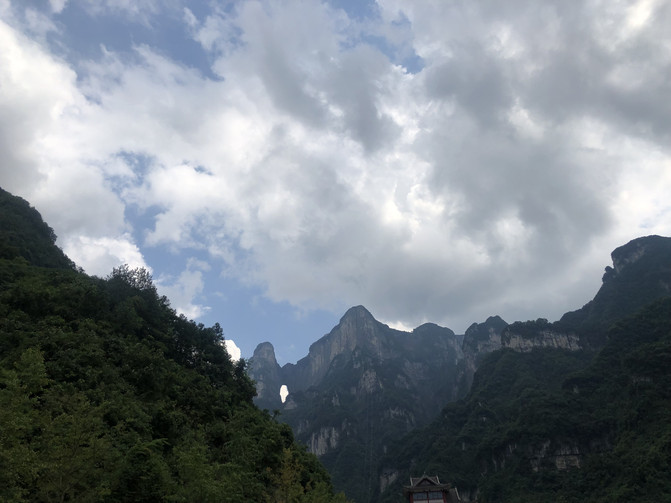
Enter the gate of the scenic area, change to the scenic area tour bus, and start the journey around the mountains! This section of the winding mountain highway is known as the 99 turns! From the moment we board the tour bus, I believe everyone's heart is in their throat! When we got off the bus, we were very convinced by the tour bus driver. We made sharp turns all the way without slowing down. We had a thrilling and soul-stirring feeling on the entire Zhuanshan Highway! Here are a few shots taken of the 99 bend on the mountain road in the car!



The tour bus took tourists directly to the foot of Tianmen Gate. When we got off the bus, the clouds in the sky slowly gathered and it felt like rain was going to rain.



It is said that in the sixth year of Wu Yong 'an of the Three Kingdoms (263 AD), a cliff hole in Songliang Mountain suddenly opened, forming Tianmen Cave, and it was named Tianmen Mountain.
The cave body runs north and south, with a gate height of 131.5 meters, a width of 57 meters and a depth of 60 meters. Smoking clouds and blowing smoke all year round is spectacular. This is simply a masterpiece of nature!
Standing under Tianmen Cave and looking up at it, I deeply feel the vastness of nature and the insignificance of people.
The idea of my son climbing up by himself may not be difficult for him, but for a middle-aged mother like me, it was really a bit difficult, so I decisively pulled him into the mountain escalator without saying a word.



Such a long escalator takes 12 times to reach the top of the mountain. The first 5 escalators can take you to Tianmen Cave to experience the feeling of being a god, and the last 7 escalators reach the top of Tianmen Mountain!
When we arrived at Tianmen Cave, the weather was beautiful and it began to rain. The clouds and mist floated past our feet, and the fairy aura lingered around it, like a fairyland.

~~~~~~~~~
Ghost Valley Plank Road
~~~~~~~~~
Continue to take the escalator up to the top of Tianmen Mountain. Let's go on the Ghost Valley Plank Road first.
Guigu Plank Road is located in the Xianxian Wonderland Scenic Area. It is named Guigu Plank Road because it hangs along the steep Guigu Plank Road on the upper side of Guigu Cave. The plank road has a total length of 1600 meters and an average altitude of 1400 meters. It starts from Yihongguan and ends at Xiaotianmen. Different from other plank roads, the entire Ghost Valley plank road is neither on the top of the cliff nor on the side of the cliff. Instead, the entire line stands in the middle of the cliff, giving people the feeling of rising and falling with the cliff. Viewed from this plank road, the scenery is breathtaking.



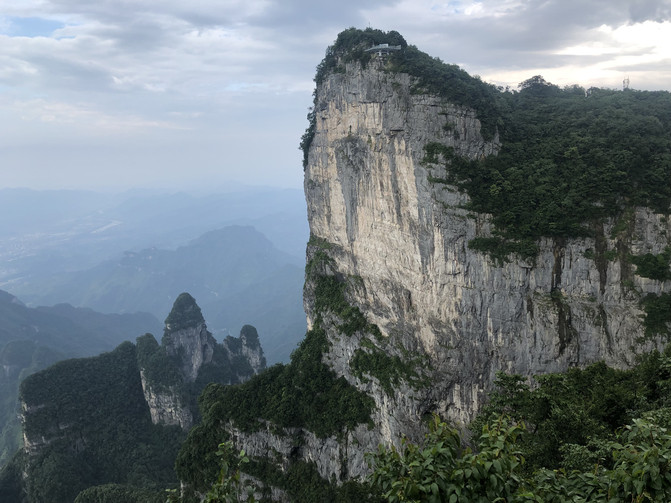

On the Ghost Valley Plank Road, I photographed another 99-turn winding mountain road, making me dizzy!


~~~~~~~~
glass boardwalk
~~~~~~~~
After walking through the Ghost Valley plank road, we are going to the exciting glass plank road. The glass plank road overhangs on the west line of Tianmen Peak. It is 60 meters long and its highest point is 1430 meters above sea level. In order to allow tourists to see the beautiful scenery through the glass bridge without blemishes, tourists on the bridge are required to wear shoe covers to keep the glass bridge transparent and clean. This is the hottest attraction. It is impossible to take a solo photo of the glass plank road. However, thanks to the large number of people, if I were to walk this glass plank road alone, I really wouldn't have the courage.







~~~~~~~~~~~~
Tianmen Mountain Cableway
~~~~~~~~~~~~
Wait for the cableway and go down the mountain. This Tianmen Mountain cableway is 7455 meters long, and the horizontal height difference between the upper and lower stations is 1279 meters. It is the first in the world. It can be slid from the top of Tianmen Mountain to the urban area of Zhangjiajie. I am looking forward to it and nervous! To be honest, this is really more exciting than the glass plank road. The glass plank road is 60 meters long, and this one is more than 7,000 meters long! After sitting on it, I really feel like I have a refreshing and powerful feeling!

As usual, there is a long line

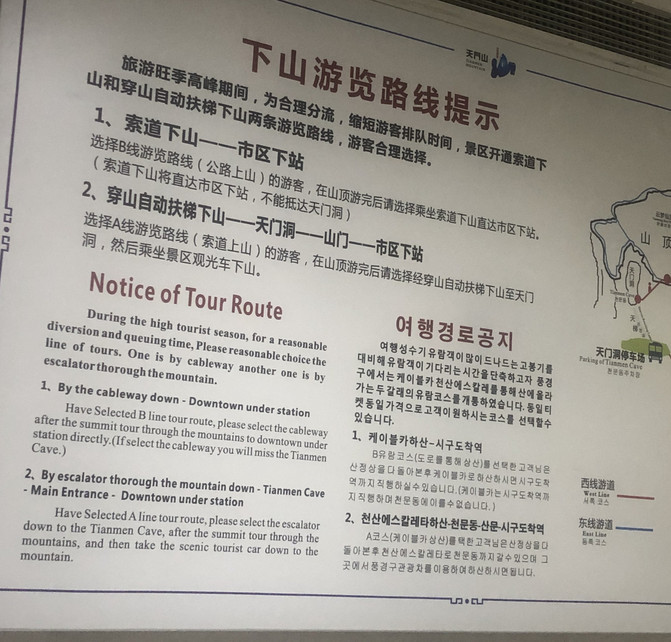

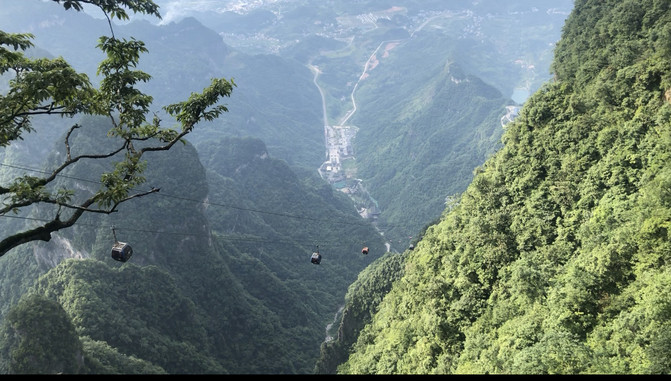



The 30-minute cableway leads to the urban area of Zhangjiajie. When we arrived in the urban area, it was dark. The night view of the entire Zhangjiajie City from the cableway is quite beautiful.
After the group meal, at about 9 o'clock, we checked into Country Garden Tourist Resort. Although you are staying at night, you can already feel the luxury of the resort from the bus. Get up early tomorrow and have a stroll.
~~~~~~~~~~~~~~~~~~~~~~~~~~~~~~~~~~~~~~~~~~~~~~~~~~~~~~~~~~~~~~
~~~~~~~~~~~~~~~~~~~~~~~~~~~~~~~~~~~~~~~~~~~~~~~~~~~~~~~~~~~~~~
[August 14, the fourth day of the itinerary: Zhangjiajie-Baofeng Lake-Furong Town-Fenghuang Ancient City]
Today's main itinerary:
Baofeng Lake--Furong Town--Night tour of Fenghuang Ancient City ~~~~~~~~~~~~~~~~~~~~~~~~~~~~~~~~~~~~~~~~~~~~~~~~~~~~~~~~~~
In the morning, I woke up to the sound of birds, took a walk in Country Garden, and breathed the fresh air between the mountains and forests. It felt great! Go back and pack your luggage, have a leisurely breakfast, and get ready to set off.





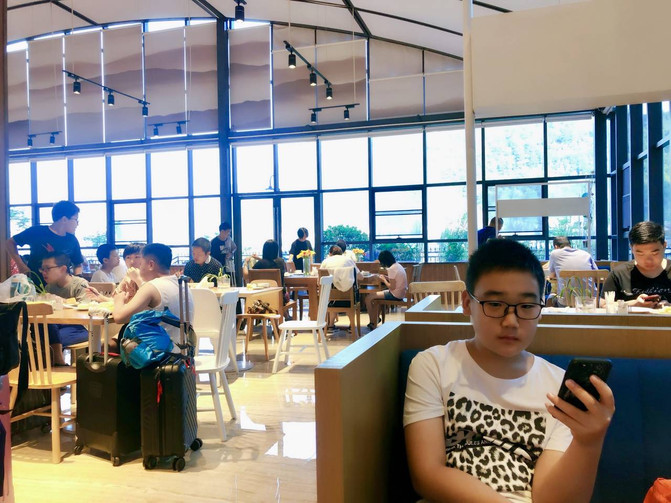
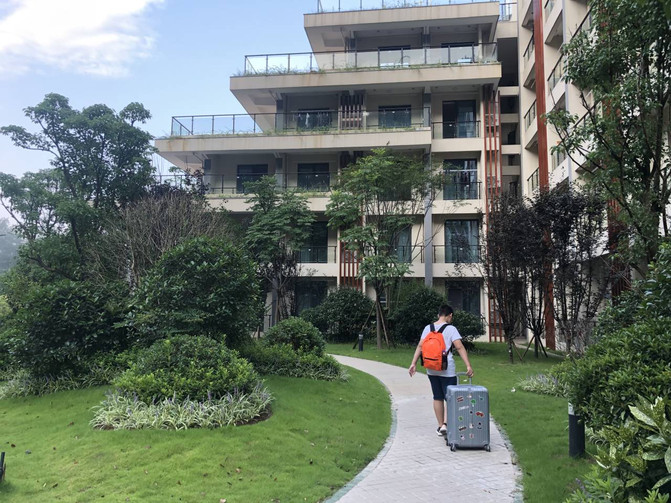

~~~~~~~~~~~~~~~~~~~~~~~~~
Today's first stop: Shopping attractions and local specialties supermarkets
~~~~~~~~~~~~~~~~~~~~~~~~~
Since it is a group tour, shopping attractions are inevitable. But we only visited one shopping attraction on this trip, which was the local specialty supermarket. Buy some chili sauce, cinnabar, kudzu root powder, and Euchides chopsticks and take them back to your family and friends. It is also a token of your heart.
~~~~~~~~~~~~~~~~~~~~~~~~~
Today's second stop: Zhangjiajie Baofeng Lake Scenic Area
~~~~~~~~~~~~~~~~~~~~~~~~~
At about 11 o'clock, we arrived at Baofeng Lake. Instead of choosing Huanglong Cave, a popular tourist attraction, I chose to come and see the water in Zhangjiajie. The scenic spot consists of two major blocks: Baofeng Lake and Yingwozhai. Among them, Baofeng Lake, Qifeng Flying Waterfall, Yingwozhai and Yixiantian are called the "Four Wonders" of Baofeng Lake. It is a boutique attraction among Wulingyuan scenic spots. It is a rare high-gorged lake, surrounded by green mountains, clear water, and beautiful scenery. It is a masterpiece of mountains and rivers.
It can also be seen from the tour buses in the scenic area that this is not an Internet celebrity attraction. However, viewing scenery is also like a life experience, and there are often unexpected surprises. Baofeng Lake Scenic Area is not large, but it is beautiful and colorful. There are two small islands in the lake. Strange peaks stand by the lake, and the peaks turn back to the water. The lake water is like a precious mirror, surrounded by green mountains, reflected by the peaks. The water is greener because of the mountains, and the mountains are greener because of the water. It is poetic and picturesque.






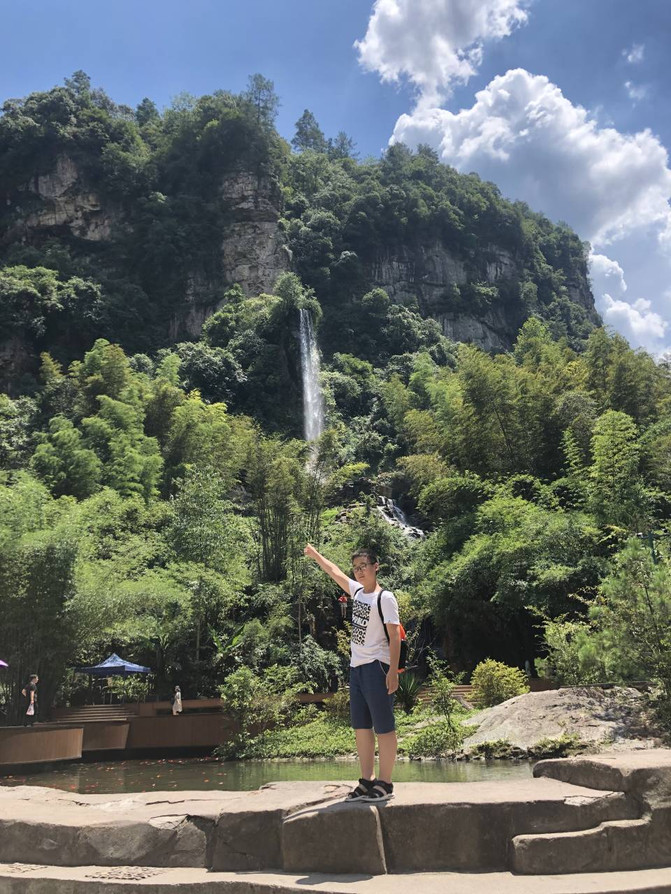










~~~~~~~~~~~~~~~~~~~~~~~~~
Today's third stop: Furong Town
~~~~~~~~~~~~~~~~~~~~~~~~~
After touring Baofeng Lake, it was almost 1 o'clock. After lunch, the bus drove for more than two hours. At 3 p.m., we arrived at Furong Town, which is known as the "Millennium Ancient Town Hanging on the Waterfall".
Furong Town, whose original name is Wangcun, is an ancient town with a history of more than 2,000 years. Because of the magnificent waterfalls shuttle through it, it is also known as the "thousand-year-old town hanging on the waterfalls." Yongshun County, located in Xiangxi Tujia and Miao Autonomous Prefecture, is known as the four famous towns in Xiangxi, along with Longshan Liye Town, Luxipu Town, and Huayuan Chadong Town. It is also known as Youyang Xiongzhen and "Little Nanjing." Later, the movie "Furong Town" starring Jiang Wen and Liu Xiaoqing was filmed here, and the name was changed to "Furong Town."
~~~~~~~~~~~~~~~~~~~
Take a Youshui pleasure boat and cross the river to the town. You can see the picturesque town inlaid on the waterfalls from the boat.



After getting off the boat at the dock, you have to climb a mountain road to get to the town.


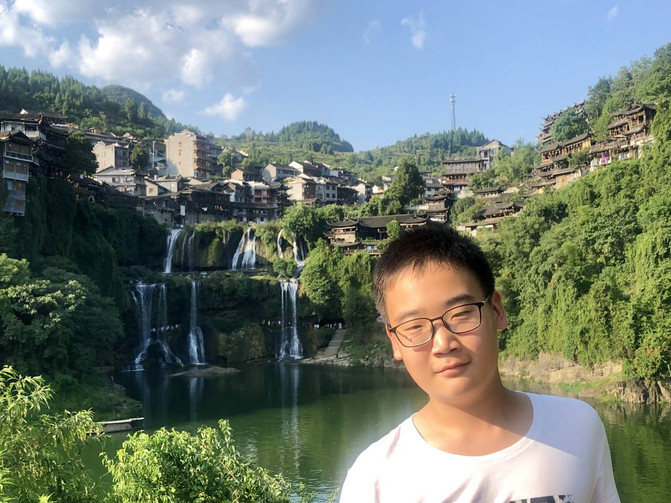




Surprisingly, tourists can walk through the waterfalls.


No matter which direction you look at, the town is beautiful! It's so beautiful that it's intoxicating!



Walking through the most beautiful waterfalls, walking into the town along the town's simple blue stone road, with mottled alleys and moldy green moss, the thousand-year-old town still exudes charm.




~~~~~~~~~~~~~~~~~~~~~~~~~
Today's fourth stop: Night tour of Fenghuang Ancient City
~~~~~~~~~~~~~~~~~~~~~~~~~
Leaving Furong Town by boat at 4:30, we are finally going to Fenghuang Ancient City! The bus took about 2 hours, and we had dinner in the middle. At about 7 o'clock, we arrived at the last and most anticipated place on the trip-Fenghuang Ancient City. Putting down their luggage, everyone gathered. Although they had already finished swimming for a day, the people at this time were all in high spirits and not tired, and they couldn't wait to see the style of the ancient city immediately.
Let's first popularize the ancient city of Phoenix:
Fenghuang Ancient City is a national historical and cultural city and one of the eight counties and cities under the jurisdiction of Xiangxi Tujia and Miao Autonomous Prefecture in Hunan Province. It was built in 1704 in the forty-third year of Kangxi of the Qing Dynasty. In 2001, it was awarded the title of National Historical and Cultural City and one of Hunan's top ten cultural heritages. It was praised by the famous new Zealand writer Louis Alley as the most beautiful small city in China. It is comparable to the ancient city of Lijiang in Yunnan and the ancient city of Pingyao in Shanxi, and enjoys the reputation of "Northern Pingyao, Southern Phoenix."
The last set of beautiful phoenix night scenes.
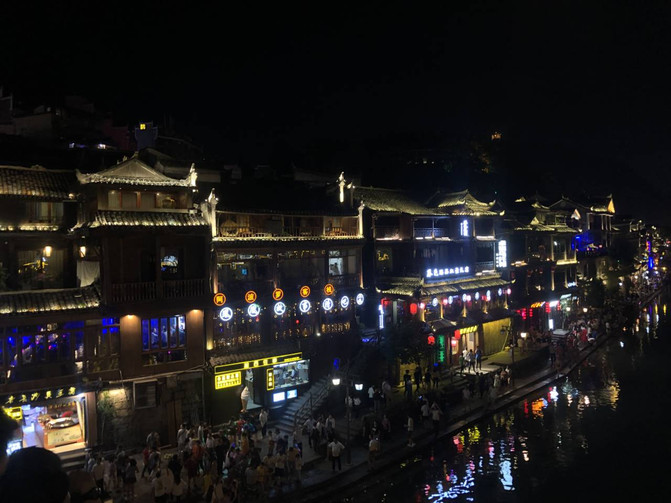



The bridge photographed below is called the "Snow Bridge". At night, climb the snow bridge and look into the ancient city, with the lights fading.







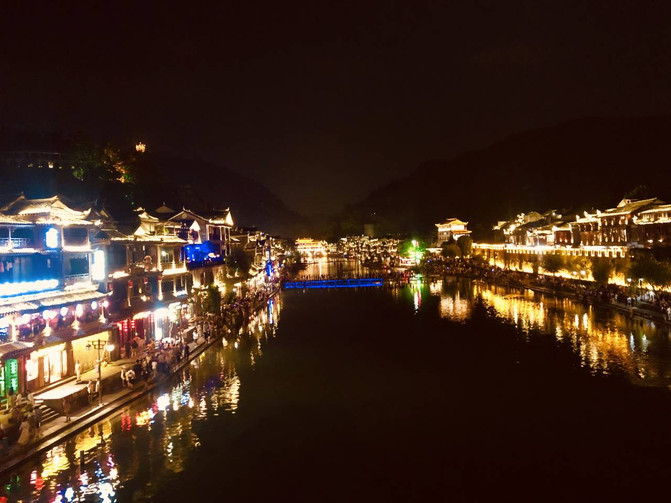
As the bustling crowd strolled along the Tuojiang River, music drifted out from the small bars on the roadside from time to time. This night is so charming.
~~~~~~~~~~~~~~~~~~~~~~~~~~~~~~~~~~~~~~~~~~~~~~~~~~~~~~~~~~~~~~
~~~~~~~~~~~~~~~~~~~~~~~~~~~~~~~~~~~~~~~~~~~~~~~~~~~~~~~~~~~~~~
[August 15, Day 5 of the itinerary: Ancient City of Fenghuang-Changsha]
Today's main itinerary:
Morning: Fenghuang Ancient City: North Gate Ancient City--East Gate Tower--Wanming Tower--Hongqiao--Shen Congwen's Former Residence--Tuojiang Hanging Tower
Evening: Changsha Pozi Street Food Street
~~~~~~~~~~~~~~~~~~~~~~~~~~~~~~~~~~~~~~~~~~~~~~~~~~~~~~~~~~~~~~
In the early morning, as we continue to stroll through the ancient city, more and more tourists gradually become more and more leisurely. It seems that encountering the misty rain and phoenix is not enough, but who can say that you are not beautiful like this?











We climbed the ancient city building from the North City Gate Building and enjoyed the ancient city's style while walking upstairs. When you reach the tower under the Dongcheng Tower Gate, you can see Wanming Tower not far away.






On the tower, I saw Chen Dounan's house. Chen Dounan's former residence was built in the 28th year of Guangxu of the Qing Dynasty (1902) and covers an area of 366.6 square meters. It consists of a forward direction, a patio, a middle hall and a backward direction. It is a clover-style courtyard with a four-water return hall surrounded by high and tight firewall. It is a typical courtyard house in Jiangnan. This long alley is called Qianjin, which is a typical "deep courtyard"



~~~~~
Wanmingta
~~~~~
Wanming Tower is located on the north bank of Shawan of Tuojiang River, facing Xiachang Pavilion and Hongqiao. The tower is six-sided and seven-level, with six angled corners on each floor. It is exquisite and beautiful, and copper wind chimes are hung. Democratic activist Tian Hedan wrote a couplet: "The clouds rise above the clouds; just on the side of the water." The body of the tower reflected in the blue waves of the Tuojiang River, swaying and looking particularly graceful and moving.




~~~~~~~
Hongqiao
~~~~~~~
Don't mistake it for that big airport in Shanghai. This Hongqiao was originally named Wuhongqiao, also known as the "Wind and Rain Tower", and was built in the early years of Hongwu of the Ming Dynasty. It is located in the center of Phoenix, making it easy to get anywhere from here. Looking at the entire Phoenix City from Hongqiao, you can have a panoramic view of the picturesque scenery on both sides of the Tuojiang River. Hongqiao is divided into two floors. The first floor is mainly for shops and grocery stores, and the second floor is a folk culture building. It contains all the calligraphy and painting works about Hongqiao Fengyu Building from ancient times to the present. It is also a good place for sightseeing and drinking tea.
I have traveled many places, crossed bridges in many places, watched clouds many times, drank many kinds of wine, but I only loved one person at the best age. -- Shen Congwen to Zhang Zhaohe
I just miss you while looking at the water. -- Shen Congwen to Zhang Zhaohe
Lao Shen left behind his longing for his lover here.
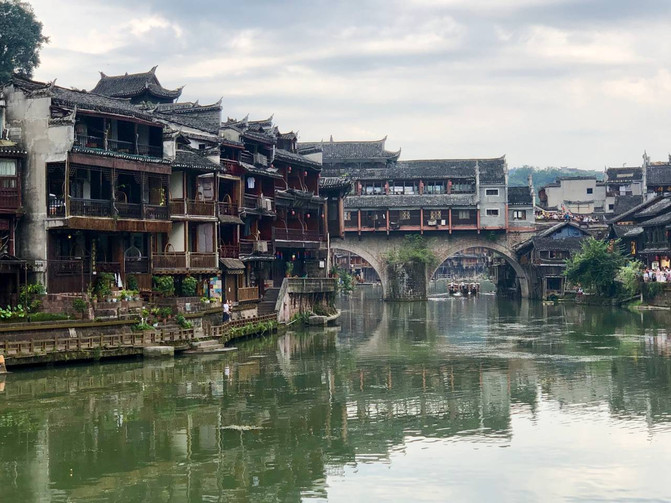

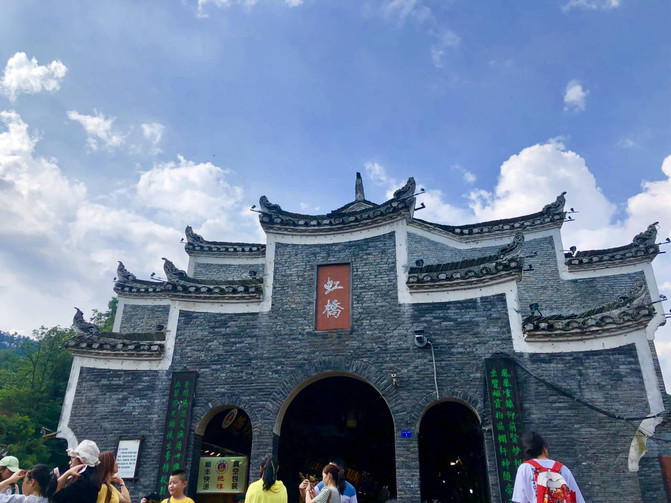

~~~~~~~~~~~~
Former Residence of Shen Congwen
~~~~~~~~~~~~
Passing through Hongqiao and exploring deep into the ancient city, we followed the guidance of signs and found the former residence of Lao Shen hidden in the alley. On December 28, 1902, a boy was born in this courtyard house of the Shen family in Zhongying Street, Zhengan (formerly known as Zhengan in the ancient city of Fenghuang), Xiangxi. This boy was later nicknamed "Shen Shezi", who skipped school every day, failed to graduate from primary school, wandered around in the army as a teenager, cooked a good pot of dog meat, wrote good calligraphy, chased a good wife, and wrote good articles. He was extremely naive and gentle, and would win the Nobel Prize in Literature a few months later. Visiting Shen Mansion, following the footsteps of the master, and feeling the aura of the master, a large part of the code of Phoenix culture is infiltrated and hidden in this seemingly ordinary ancient house.






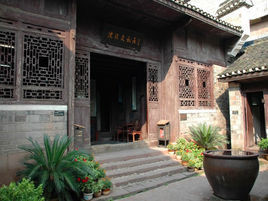

~~~~~~~~~~~~
Tuojiang Diaojiaolou
~~~~~~~~~~~~
Residential houses with Hui-style buildings can be seen everywhere in the ancient city of Fenghuang. According to folk commentators, these buildings were built by Jiangxi people. However, the only oldest Miao family suspended-foot buildings are those deep in the ancient city and near the river. They record the ups and downs of the ancient city for more than 300 years. What is rare is that these Miao family suspended-foot buildings are still the residence of the Miao family.


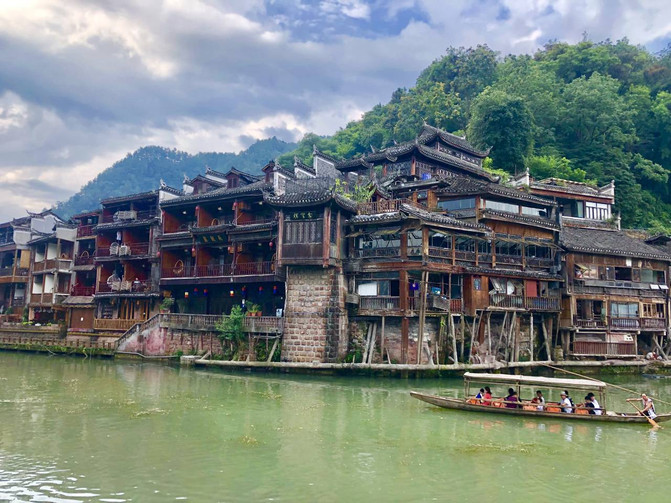


After many people came to the ancient city of Fenghuang, they thought that the current ancient city was too commercial and lost its original simplicity and mystery.
But I think,
Isn't it good that today's ancient city continues to show its vivid charm in ancient times?
Wouldn't it be good to let the ancient city become a key, open the tunnel of time and space, connect the past and the present, connect the ancients and the present?
Isn't it good that the ancient city, in the change of time, engraved the thickness of history, but allowed the wheel of history to move forward?
In ancient and modern times, the ancient city, with its inherent mystery and an unburied temperament, still exudes a seductive beauty among the bustling crowd. This is the charm of the ancient city of Phoenix.









The beautiful journey to the ancient city of Fenghuang is coming to an end. There are still countless fresh alleys and touching stories in the ancient city, which will be left for the future. Take a few more photos with her to cherish this wonderful encounter!
~~~~~~~~~~~~~~~~~~~~~~~
Today's second stop: Changsha Pozi Street Food City
~~~~~~~~~~~~~~~~~~~~~~~
At 11 o'clock in the afternoon, we ended our trip to Fenghuang Ancient City. After a quick lunch, at 12 o'clock, we got on the return bus. After an 8-hour long journey, we returned to the center of Changsha City and stayed at the Tianxia Dongting Hotel, which is very close to the subway entrance. I made an appointment with another mother in the group and took the children to Pozi Street, the most famous food street in Changsha, to taste delicious food!
Butter cake, kebabs, sesame, charge-grilled oysters, honey chicken wings ~~ I feel full all the way!





At 11 o'clock, we returned to the hotel, packed our bags, and we will go home tomorrow!
~~~~~~~~~~~~~~~~~~~~~~~~~~~~~~~~~~~~~~~~~~~~~~~~~~~~~~~~~~~~~~~~~~~~~
~~~~~~~~~~~~~~~~~~~~~~~~~~~~~~~~~~~~~~~~~~~~~~~~~~~~~~~~~~~~~~~~~~~~~
[August 16, Day 6 of the itinerary: Changsha-Jinan]
Today's main itinerary is going home!
~~~~~~~~~~~~~~~~~~~~~~~~~~~~~~~~~~~~~~~~~~~~~~~~~~~~~~~~~~~~~~
At 6 o'clock in the morning, the delivery master safely sent us to Huanghua Airport, changed our boarding passes, checked our luggage, and we were eager to get home!
The plane took off at 7:15, and we arrived in Jinan safely at 9:15!
At this point, my son and I had a beautiful trip to Xiangxi.
We are all looking forward to the next more harmonious and exciting journey!
